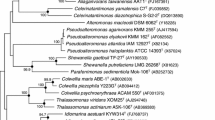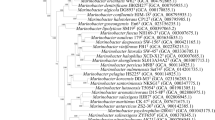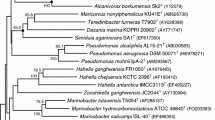Abstract
A novel agarolytic, Gram-stain negative, heterotrophic, facultatively anaerobic and pale-white pigmented bacterial strain, designated Q1T, was isolated from the marine alga Porphyra yezoensis Ueda (AST58-103) collected from the coastal area of Weihai, China. The cells are motile by means of peritrichous flagella. The isolate requires NaCl for growth, while seawater is not necessary, and growth occurs optimally at about 30–33 °C, in 1–3 % (w/v) NaCl and at pH 7–7.5. Strain Q1T shows oxidase-positive and catalase-negative activities, and possesses the ability to hydrolyse starch and alginate, but not cellulose, gelatin, urea or Tween-80. Phylogenetic analysis based on 16S rRNA gene sequence indicated that strain Q1T is affiliated with the family Alteromonadaceae within the class Gammaproteobacteria. The isolate, strain Q1T, is most closely related to Catenovulum agarivorans YM01T (94.85 %), with less than 91.2 % sequence similarity to other close relatives with validly published names. The draft genome sequence of strain Q1T consists of 62 contigs (>200 bp) of 4,548,270 bp. The genomes of Q1T and YM01T have an ANI value of 70.7 %, and the POCP value between the two genomes is 64.4 %. The genomic DNA G+C content of strain Q1T is 37.9 mol% as calculated from the draft genome sequence. The main isoprenoid quinone is ubiquinone-8. The predominant cellular fatty acids are summed feature 3 (C16:1 ω7c and/or iso-C15:0 2-OH), C16:0 and C18:1 ω7c. The major polar lipids are phosphatidylethanolamine and phosphatidylglycerol. Based on data from a polyphasic chemotaxonomic, physiological and biochemical study, strain Q1T should be classified as a novel species of the genus Catenovulum, for which the name Catenovulum maritimus sp. nov. is proposed. The type strain is Q1T (=CICC 10836T=DSM 28813T).

Similar content being viewed by others
References
Baumann L, Baumann P, Mandel M, Allen RD (1972) Taxonomy of aerobic marine eubacteria. J Bacteriol 110:402–429
Chi WJ, Park JS, Kwak MJ, Kim JF, Chang YK, Hong SK (2013) Isolation and characterization of a novel agar-degrading marine bacterium, Gayadomonas joobiniege gen, nov, sp. nov., from the Southern Sea, Korea. J Microbiol Biotechnol 23(11):1509–1518
Cowan ST, Steel KJ (1974) Bacterial characters and characterization. In: Cowan ST (ed) Cowan and Steel’s manual for the identification of medical bacteria, 2nd edn. Cambridge University Press, Cambridge
Goris J, Konstantinidis KT, Klappenbach JA, Coenye T, Vandamme P, Tiedje JM (2007) DNA–DNA hybridization values and their relationship to whole-genome sequence similarities. Int J Syst Evol Microbiol 57:81–91
Hiraishi A, Ueda Y, Ishihara J, Mori T (1996) Comparative lipoquinone analysis of influent sewage and activated sludge by high-performance liquid chromatography and photodiode array detection. J Gen Appl Microbiol 42:457–469
Ivanova EP, Mikhailov VV (2001) A new family, Alteromonadaceae fam. nov., including marine proteobacteria of the genera Alteromonas, Pseudoalteromonas, Idiomarina, and Colwellia. Mikrobiologiya 70:15–23 (in Russian). English translation: Microbiology 70:10–17
Ivanova EP, Flavier S, Christen R (2004) Phylogenetic relationships among marine Alteromonas-like proteobacteria: emended description of the family Alteromonadaceae and proposal of Pseudoalteromonadaceae fam. nov., Colwelliaceae fam. nov., Shewanellaceae fam. nov., Moritellaceae fam. nov., Ferrimonadaceae fam. nov., Idiomarinaceae fam. nov. and Psychromonadaceae fam. nov. Int J Syst Evol Microbiol 54:1773–1788
Jean WD, Chen JS, Lin YT, Shieh WY (2006) Bowmanella denitrificans gen. nov., sp. nov., a denitrifying bacterium isolated from seawater from An-Ping Harbour, Taiwan. Int J Syst Evol Microbiol 56:2463–2467
Jean WD, Huang SP, Liu TY, Chen JS, Shieh WY (2009) Aliagarivorans marinus gen. nov., sp. nov. and Aliagarivorans taiwanensis sp. nov., facultatively anaerobic marine bacteria capable of agar degradation. Int J Syst Evol Microbiol 59:1880–1887
Jeon CO, Lim JM, Park DJ, Kim CJ (2005) Salinimonas chungwhensis gen. nov., sp. nov., a moderately halophilic bacterium from a solar saltern in Korea. Int J Syst Evol Microbiol 55:239–243
Kim OS, Cho YJ, Lee K (2012) Introducing EzTaxon-e: a prokaryotic 16S rRNA gene sequence database with phylotypes that represent uncultured species. Int J Syst Evol Microbiol 62:716–772
Kurahashi M, Yokota A (2004) Agarivorans albus gen. nov., sp. nov., a γ-proteobacterium isolated from marine animals. Int J Syst Evol Microbiol 54:693–697
Liu QQ, Wang Y, Li J, Du ZJ, Chen GJ (2014) Saccharicrinis carchari sp. nov., isolated from a shark, and emended descriptions of the genus Saccharicrinis and Saccharicrinis fermentans. Int J Syst Evol Microbiol 64:2204–2209
Mesbah M, Premachandran U, Whitman WB (1989) Precise measurement of the G+C content of deoxyribonucleic acid by high-performance liquid chromatography. Int J Syst Bacteriol 39:159–167
Qin QL, Xie BB, Zhang XY, Chen XL, Zhou BC, Zhou JZ, Oren A, Zhang YZ (2014) A proposed genus boundary for the prokaryotes based on genomic insights. J Bacteriol 196(12):2210–2215
Smibert RM, Krieg NR (1994) Phenotypic characterization. In: Gerhardt P, Murray RGE, Wood WA, Krieg NR (eds) Methods for general, molecular bacteriology. American Society for Microbiology, Washington, DC, pp 607–654
Tamaoka J, Komagata K (1984) Determination of DNA base composition by reversed-phase high-performance liquid chromatography. FEMS Microbiol Lett 25:125–128
Tamura K, Stecher G, Peterson D, Filipski A, Kumar S (2013) MEGA6: molecular evolutionary genetics analysis version 6.0. Mol Biol Evol 30:2725–2729
Thompson JD, Gibson TJ, Plewniak F, Jeanmougin F, Higgins DG (1997) The CLUSTAL_X windows interface: flexible strategies for multiple sequence alignment aided by quality analysis tools. Nucleic Acids Res 25:4876–4882
Tindall BJ, Sikorski J, Smibert RM, Kreig NR (2007) Phenotypic characterization and the principles of comparative systematics. In: Reddy CA et al (eds) Methods for general and molecular microbiology. American Society for Microbiology, Washington, DC, pp 330–393
Urios L, Intertaglia L, Lesongeur F, Lebaron P (2008) Haliea salexigens gen. nov., sp. nov., a member of the Gammaproteobacteria from the Mediterranean Sea. Int J Syst Evol Microbiol 58:1233–1237
Yan S, Yu M, Wang Y, Shen C, Zhang XH (2011) Catenovulum agarivorans gen. nov., sp. nov., a peritrichously flagellated, chain-forming, agar-hydrolysing gammaproteobacterium from seawater. Int J Syst Evol Microbiol 61:2866–2873
Yi H, Bae KS, Chun J (2004) Aestuariibacter salexigens gen. nov., sp. nov. and Aestuariibacter halophilus sp. nov., isolated from tidal flat sediment, and emended description of Alteromonas macleodii. Int J Syst Evol Microbiol 54:571–577
Acknowledgments
This work was supported by the National Natural Science Foundation of China (31370057), the National Science and Technology Major Project of China (2013ZX10004217), Shandong Provincial Programs for Science and Technology Development of China (2011GSF12108), and the 2013 Shandong Provincial Second Group Projects on Resource Platforms for Marine Economic and Innovative Development Regions: Marine Microorganisms Preservation Platform (2150299). We thank Prof. Xiao-Hua Zhang for kindly providing the reference strain Catenovulum agarivorans YM01T.
Author information
Authors and Affiliations
Corresponding author
Additional information
The GenBank accession number for the 16S rRNA gene sequence of Catenovulum maritimus Q1T is KJ659912.
Electronic supplementary material
Below is the link to the electronic supplementary material.
Rights and permissions
About this article
Cite this article
Li, DQ., Zhou, YX., Liu, T. et al. Catenovulum maritimus sp. nov., a novel agarolytic gammaproteobacterium isolated from the marine alga Porphyra yezoensis Ueda (AST58-103), and emended description of the genus Catenovulum . Antonie van Leeuwenhoek 108, 427–434 (2015). https://doi.org/10.1007/s10482-015-0495-2
Received:
Accepted:
Published:
Issue Date:
DOI: https://doi.org/10.1007/s10482-015-0495-2




